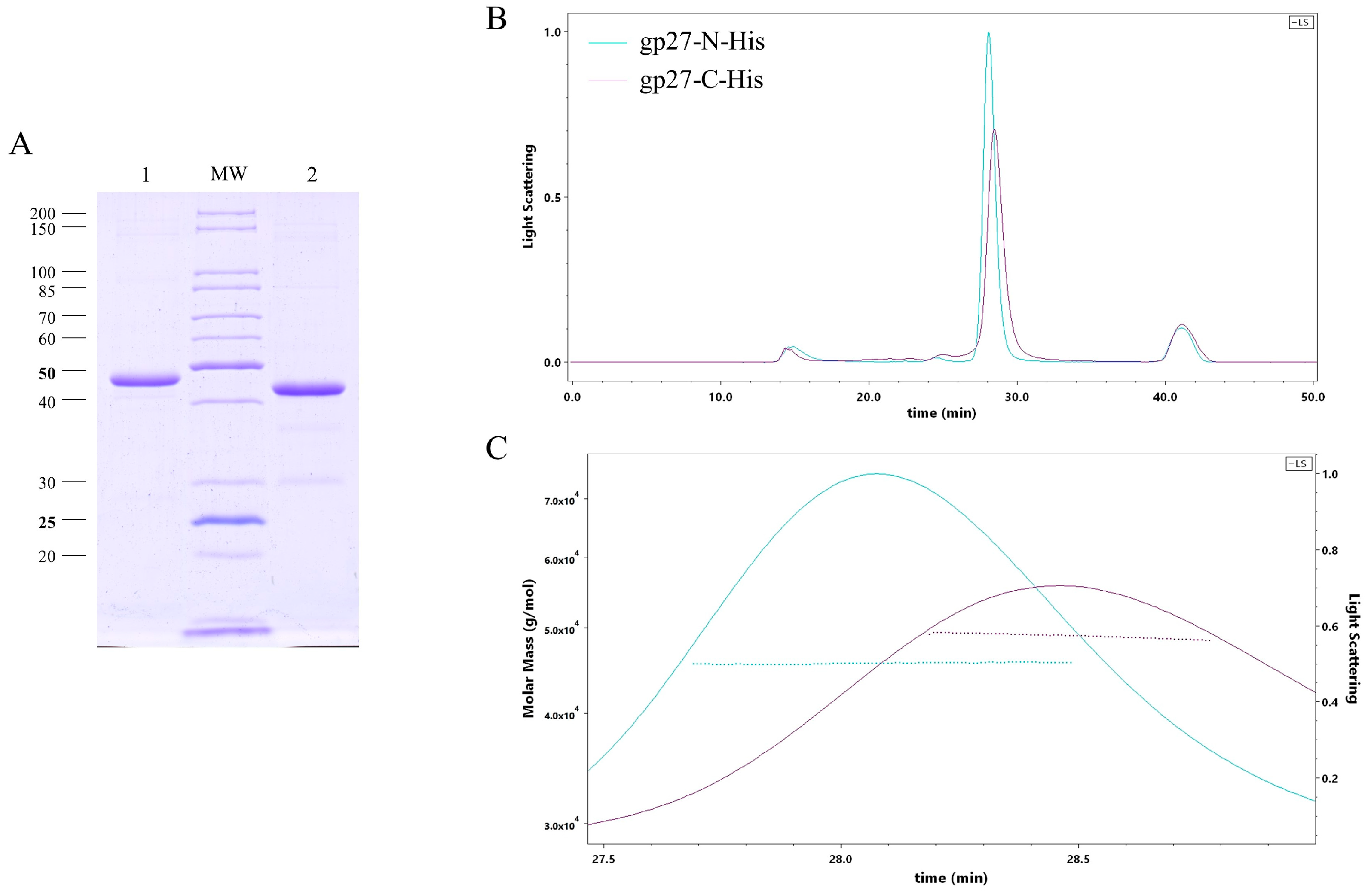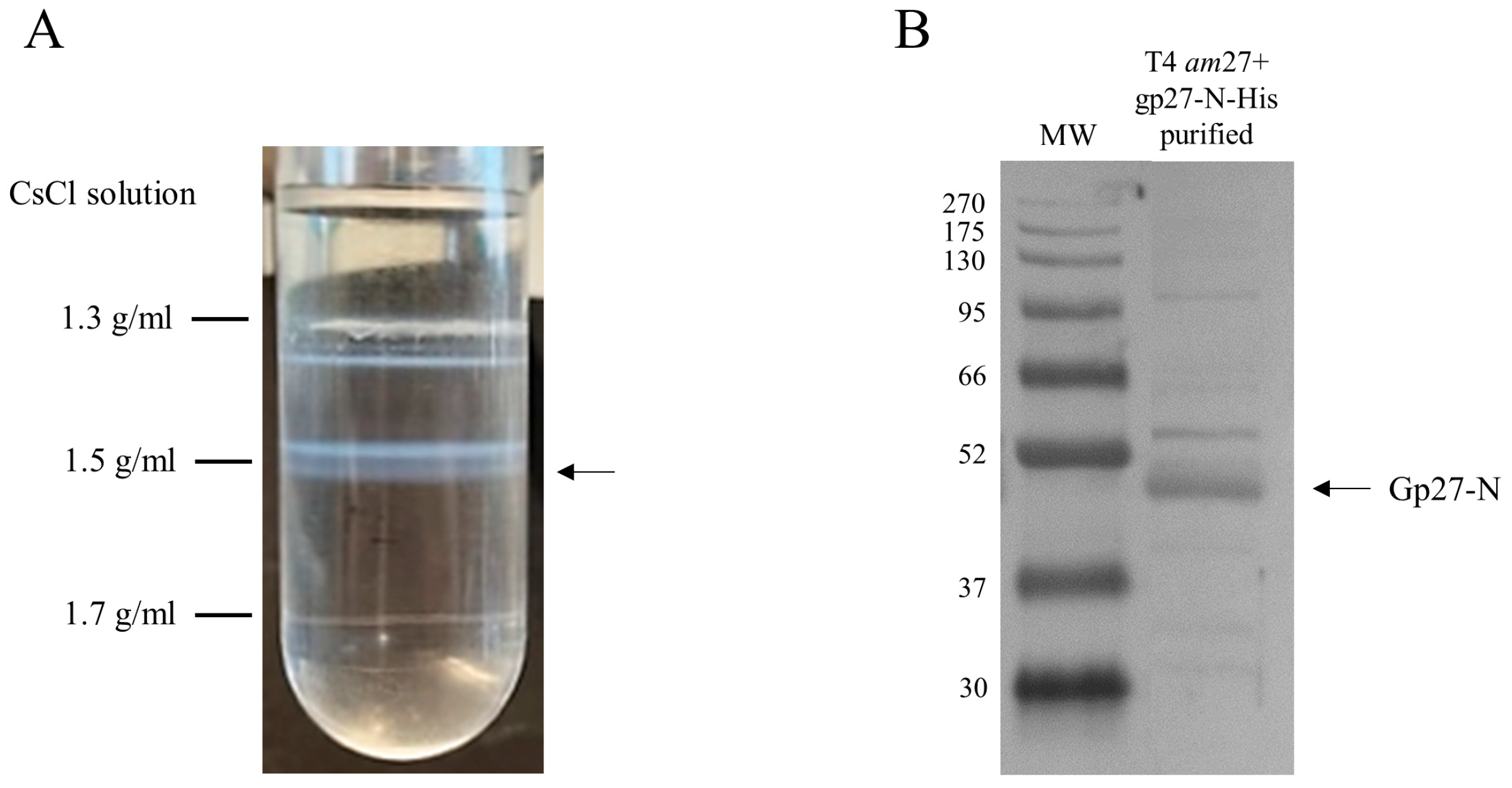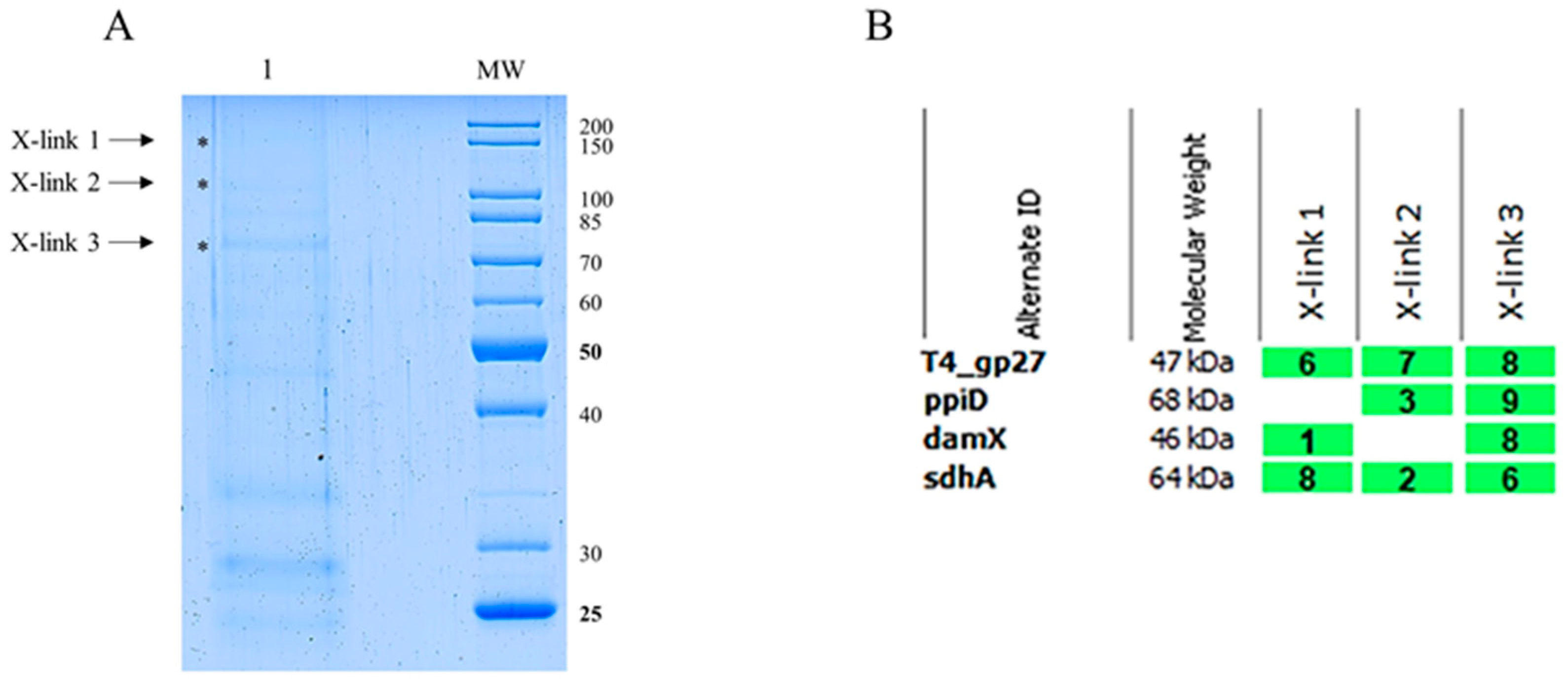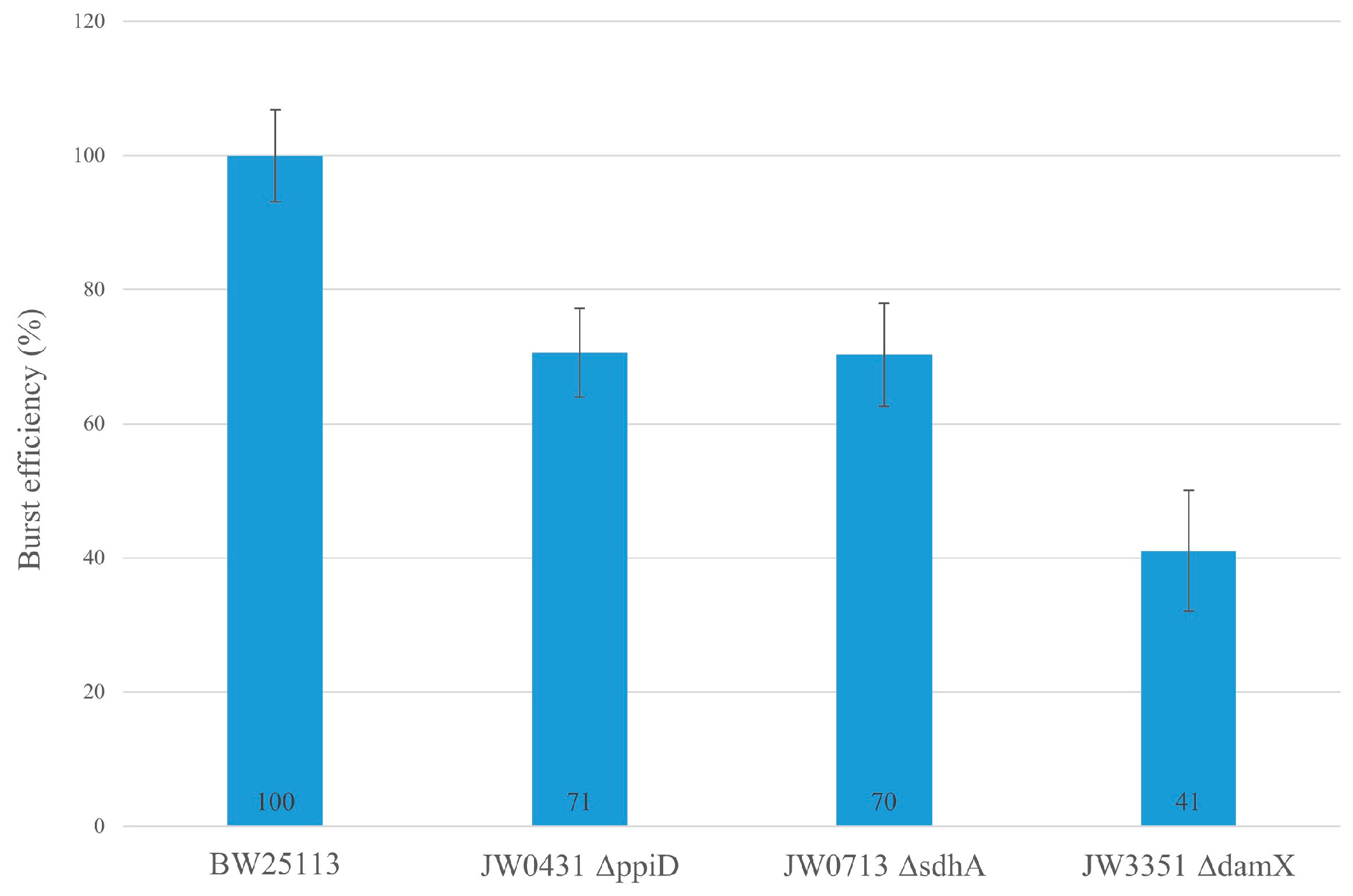1. Introduction
Bacteriophage recognizes its host cell by the tail fibers contacting the bacterial outer surface, initiating the complicated process of adsorption. Myophage T4 has six long, mobile tail fibers that are involved in this first step of finding the proper host receptor in a still reversible interaction [
1]. In a second step, which leads to an irreversible and tight adsorption, the short tail fibers bind to the cell surface by a concomitant movement of gp9, resulting in a conformational change within the baseplate of the phage particle [
2]. The conformational change in the baseplate initiates a wave-like rearrangement of the tail sheath, resulting in a contraction of the tail [
3]. Since the inner tail tube of T4 does not contract, it becomes exposed to the surrounding vicinity together with the former baseplate components gp5.4, gp5 and gp27 at its tip [
2]. The stiff triple-helical structure of gp5, called the needle, is mechanically pushed through the outer membrane during the tail contraction reaction.
In the periplasm, the tip of the needle, consisting of gp5.4 and the C-terminal part of gp5 (gp5C), is thought to fall off and bind to PpiD, a periplasmic isomerase [
4]. The N-terminal portion of gp5 (gp5*) encompasses a lysozyme domain that locally digests the peptidoglycan layer, paving the way for the tail tip structure to move through the periplasm towards the outer face of the cytoplasmic membrane [
5]. The trimeric gp27 is bound to the N-terminal part of the gp5 trimer (gp5N) and forms a cylindrical pore suitable to allow the passage of a double-stranded DNA [
6].
Currently unknown is what happens at the inner membrane. Possibly, the tail tip inserts itself into the membrane bilayer and forms a channel for the phage DNA to translocate into the cytoplasm of the host. Alternatively, the tail tip binds to an inner membrane protein that supports the phage DNA translocation. To investigate this, we have generated T4 phage particles that carry a modified gp27 protein with a His-tag. Following infection with the modified phage in the presence of a chemical cross-linker then allows to identify and, later, isolate proteins that contact gp27 during the infection process by affinity chromatography. The major gp27-bound host proteins were identified as the periplasmic isomerase PpiD, the divisome complex component DamX, and the sulfate dehydrogenase subunit SdhA.
The same cross-linking partner proteins were found when purified gp27-N-His was directly applied onto spheroplasts, suggesting that these proteins are specifically recognized by gp27. E. coli strains that have deletions in one of the suspected partner proteins were then tested as hosts for T4 infection. When the cell division protein DamX was deleted, the efficiency to infect a cell was significantly reduced to about 40%, suggesting that DamX considerably contributes to a highly productive T4 infection.
2. Materials and Methods
2.1. Bacterial Strains, Bacteriophages, and Culture Conditions
All bacteria, plasmids and bacteriophages used in this work are listed in
Table 1. Medium preparation and bacterial growth were performed according to standard methods [
7].
2.2. Plasmid Construction
Gene 27 of the phage T4 was amplified by PCR from the T4 genome DNA with primers that were designed for the C-terminal histidine tag to add a PciI and MfeI site to both ends of the PCR product. Thus, the forward primer began with a PciI site as 5′-AC ATG TCA ATG TTG CAA CGC CCC GGA TAT CCA-3′ and reverse 5′-CAA TTG CTT ATT GGA AGA ACT ACT TTC TTC AGT GG-3′. For the N-terminal histidine tag, the forward primer 5′-C CAG CTC GAG ATG AGT ATG TTG CAA CGC-3′ and the reverse primer 5′-CC AGG GGA TCC TTA TTG CTT ATT GGA AGA AC-3′ were used. Each PCR was performed with GoTaq DNA polymerase (Promega) for 40 cycles with T4 DNA. The PCR products were purified (Illustra), digested for the C-terminal His-tag with PciI and MfeI and for the N-terminal His-tag with XhoI and BamHI and ligated to the modified expression vectors pET22b with a TEV site and expression vector pET16b, respectively. For the propagation of the His-modified T4 amber27 phages, gp27-N was subcloned into pGZ119EH.
2.3. Purification of gp27 Constructs
E. coli cells were transformed with plasmids encoding gp27 with either a C-terminal 11xHis-tag (gp27-C) or an N-terminal 10xHis-tag (gp27-N). The cells were cultured in a 2xYT medium containing 200 µg/mL ampicillin at 37 °C until the cultures reached the OD600 of 0.6. Subsequently, the culture temperature was reduced to 18°C, and gp27 expression was induced by the addition of isopropyl-ß-D-thiogalactopyranoside (IPTG) to a final concentration of 0.5 mM. The induced cells were grown at 18 °C overnight, and harvested by centrifugation at 8000× g and 4 °C for 10 min the next day. The resulting cell pellets were resuspended in a lysis buffer (50 mM Tris-HCl [pH 8], 150 mM NaCl, 1 mM dithiothreitol [DTT], 1 mM ethylendiamine tetraacetic acid [EDTA]) on ice and lysed by four passages in a French pressure cell at 16,000 psi. Before cell disruption 1 mM phenylmethylsulfonyl fluoride (PMSF), a spatula tip of DNaseI and 1 mM MgCl2 were added. The lysate was then centrifuged at 10,000× g and 4 °C for 15 min. The supernatant and Ni Sepharose 6 Fast Flow slurry were incubated at 4 °C for 45 min on a rotating wheel. The sample was loaded onto a 5 mL column and the flow through collected. After washing the matrix with 20 mL of the wash buffer (50 mM Tris-HCl [pH 8], 300 mM NaCl, 35 mM imidazole), the proteins were eluted with 10 mL elution buffer (50 mM Tris-HCl [pH 8], 150 mM NaCl, 300 mM imidazole, 1 mM DTT) in 2 mL fractions. The elution fractions containing the target proteins were further purified by size-exclusion chromatography (SEC). The samples were loaded onto a Superdex 200 increase 10/300 GL column connected to an AEKTA purifier 10 system, and eluted with gel filtration buffer (20 mM Tris-HCl [pH 8], 150 mM NaCl, 10% glycerol).
2.4. Size Exclusion Chromatography—Multi-Angle Light Scattering (SEC-MALS)
The SEC-MALS method employed in this study was previously reported [
4]. Protein samples were injected onto a Superdex 200 increase 10/300 GL column, pre-equilibrated with a SEC buffer (20 mM Tris-HCl [pH 8], 150 mM NaCl). The SEC column was integrated with a static 3-angle light-scattering detector (miniDAWN Treos II) and a refractive-index detector (Optilab T-rEX) (Wyatt Technology, Santa Barbara, CA, USA). Data acquisition was performed at a frequency of one measurement per second, maintaining a flow rate of 0.5 mL/min throughout the experiment. Data analysis was carried out using ASTRA VII software version 7.3.2.21, which facilitated the molar weight determination of the protein sample. To ensure accuracy and reliability, the light-scattering detectors underwent normalization, and data quality was verified by utilizing a bovine serum albumin (BSA) standard (Thermo, Waltham, MA, USA).
2.5. Liposome Preparation
The liposomes utilized in this study were prepared using
E. coli lipids (Avanti) 1-palmitoyl-2-oleoyl-sn-glycero-3-phosphoethanolamine (POPE) and 1-palmitoyl-2-oleoyl-sn-glycero-3-phospho-glycerol (POPG). The lipids were initially dissolved in dichloromethane and subsequently evaporated under a stream of nitrogen to remove the solvent [
10]. The resulting dry lipid layers were dissolved in lipid buffer (50 mM Tris-HCl [pH 7.4] and 150 mM NaCl). To mimic the membrane-lipid composition of
E. coli, a 7:3 ratio of PE to PG was used. To obtain a homogeneous size distribution, unilamellar liposomes with an average diameter ranging from 250 to 300 nm were generated by extrusion (Mini extruder, Avanti Polar Lipids, Inc., Alabaster, AL, USA) through a 0.4 µm polycarbonate membrane (Whatman) [
10,
11]. Subsequently, dynamic light scattering (DLS) was used to measure the size distribution of the lipid vesicles.
2.6. Spheroplast Preparation
For the purpose of cross-linking experiments, spheroplasts were generated from E. coli C3022 cells harboring plasmid pMAL-p5X expressing the maltose binding protein MBP as periplasmic control. The bacterial culture was centrifuged at room temperature (RT) and 8000× g for 5 min. The cell pellet was resuspended in 50 µL spheroplasting buffer (200 mM Tris-HCl [pH 7.4], 20% sucrose, 1 mM EDTA, 30 U/µL lysozyme), and incubated for 5 min at RT. Osmotic shock was accomplished by adding 150 µL of 20 mM Tris-HCl (pH 7.4) containing 20 mM MgCl2 for spheroplast stabilization. The sample was further incubated for 5 min and centrifuged at 6000× g for 3 min to remove the spheroplasts and intact cells from the supernatant. The recovered supernatant was designated as the periplasmic fraction. The resulting pellet, containing the spheroplasts and intact cells, was then carefully resuspended in reaction buffer (20 mM Tris-HCl [pH 7.4], 150 mM NaCl, 20 mM MgCl2).
2.7. PpiD and DamX Purification
The purification protocol for PpiD has been previously documented [
4].
E. coli PpiD was expressed from plasmid pASK-IBA3C, which encodes PpiD with a C-terminal Strep-tag (kindly provided by HG Koch, Freiburg). Cultivation was conducted in BL21 (DE3) cells in LB medium supplemented with 25 µg/mL chloramphenicol at 37 °C. Induction was initiated by adding anhydrotetracycline to a final concentration of 200 µg/L for 2 h at 37 °C. Cells were harvested via centrifugation at 10,000×
g and 4 °C for 15 min. The resulting cell pellets were resuspended in buffer P (50 mM Tris-HCl [pH 7.4], 50 mM NaCl, 1 mM EDTA) on ice and lysed by four passages in a French pressure cell at 16,000 psi. Prior to cell disruption, 1 mM PMSF, a spatula tip of DNaseI, and 1 mM MgCl
2 were added. The lysate was centrifugated at 35,000×
g and 4 °C for 45 min. The pellet was resuspended in buffer A containing 1% N-lauroylsarcosine to solubilize the inner membrane at 4 °C overnight. The solubilized membrane fraction was collected by ultracentrifugation at 110,000×
g at 4 °C for 40 min.
E. coli DamX, expressed from plasmid pMS119EH encoding DamX with an N-terminal Strep-tag, was cultured in MG1655 cells in LB medium supplemented with 100 µg/mL ampicillin at 37 °C until the culture reached an OD600 of 0.5. Induction was initiated by adding 0.5 mM IPTG for 4 h at 37 °C. Cells were harvested via centrifugation at 8000× g and 4 °C for 10 min. The cell pellets were resuspended in buffer D (50 mM Tris-HCl [pH 8], 150 mM NaCl) on ice and lysed by four passages in a French pressure cell at 16,000 psi. Prior to cell disruption, 1 mM PMSF, a spatula tip of DNaseI, and 1 mM MgCl2 were added. The lysate underwent centrifugation at 70,000× g and 4 °C for 30 min.
Both PpiD and DamX supernatants were loaded onto 0.5 mL of Strep-Tactin® Sepharose matrix (IBA Lifescience, Göttingen, Germany). After washing the matrix with 5 mL of buffer W (100 mM Tris-HCl [pH 8], 150 mM NaCl, 0.1 mM Na2EDTA × 2H2O), the proteins were eluted with 2.5 mL of buffer E (100 mM Tris-HCl [pH 8], 150 mM NaCl, 0.1 mM Na2EDTA × 2H2O, 2.5 mM D-desthiobiotine) in 500 µL fractions. The elution fractions containing the target proteins were further purified by SEC performed with a Superdex 200 increase 10/300 GL column connected to an AEKTA purifier 10 system in buffer P for PpiD and in buffer D containing 10% glycerol for DamX.
2.8. Modified T4 amber27 Phage Preparation and Purification
E. coli C2523 cells harboring plasmid pGZ119EH encoding gp27-N-His were grown in LB medium containing 25 µg/mL chloramphenicol at 37 °C until the culture had reached an OD600 of 0.6. The culture was induced by the addition of 0.3 mM IPTG for 10 min. Then, the cells were infected by T4 amber27 phages with a m.o.i. of 5 and after 7 min superinfected by additional phage with a m.o.i. of 5 for 53 min. The cells were harvested by centrifugation with 6000× g at 25 °C for 15 min. The pellet was resuspended in phosphate buffer containing 1 mM MgSO4 at 4 °C overnight. The next day, the pellet was treated with 0.05% Triton-X-100 at RT for 1h and centrifuged at 6000× g for 15 min to remove the cell debris and intact cells from the supernatant. The supernatant was recovered, and the phage was further purified in a cesium chloride (CsCl) step gradient ultracentrifugation in a SW28 rotor with 110,000× g at 18 °C for 2 h. The phage band was collected by using a sterile syringe and cannula and dialyzed against buffer T4 (20 mM Tris-HCl [pH 7.4], 20 mM NaCl, 10 mM MgCl2).
2.9. Efficiency of T4 Phage Infection
Overnight bacterial cultures of
E. coli strain BW25113 and its deletion mutants JW0431∆
ppiD, JW0713∆
sdhA and JW3351∆
damX from the Keio collection [
8] were diluted into 3 mL fresh LB medium. LB medium for the Keio collection strains included an additional 25 µg/mL of kanamycin. The cultures were grown at 37 °C until they had reached an OD
600 of 0.6. Subsequently, the cells were infected by T4D with a m.o.i. of 5 for 1 h at 37 °C. Following the infection period, the cultures were treated with 75 µL chloroform and left for 5 min at RT. Then, the cell debris was pelleted by centrifugation of the supernatant (excluding chloroform) with 10,000×
g for 2 min. The phage titer of each T4 infection was determined on BW25113 cell lawns. In this assay, BW25113 cells were grown to an OD
600 of 1.0 and 300 µL of the culture was mixed with top agar and the serial dilutions of T4 phages. The mixture was then poured onto Hershey bottom plates and incubated overnight at 37 °C.
4. Discussion
The bacterial host proteins that are first contacted by the infecting T4 phage are the receptor proteins in the outer membrane [
12]; in addition, there is binding to the lipopolysaccharides. During the penetration of the contracted phage tail into the host cell wall, the invading tail core structure locally digests the peptidoglycan layer due to the enzymatic action of the lysozyme moiety of gp5* on the tail tip. Later in infection, the gp5 lysozyme is inactivated by the T4 spackle protein which is secreted into the periplasm [
13]. The needle structure composed of gp5C and gp5.4 then has to be removed from the tail since its tight ß-helical structure would not allow the phage DNA to pass through the phage tail. This leaves gp5N and gp27 exposed at the tail tip to then interact with the membrane surface. It has been speculated [
14] that gp5N also leaves the tail tip when it arrives in the periplasm and that the gp27 trimer opens up to let the DNA pass through. This might happen after contacting the surface of the inner membrane, possibly at a receptor protein. Whereas gp27 does not firmly bind to liposomes (
Figure 2B; [
4]), we found that it interacts with spheroplasts (
Figure 3A). Based on this observation, we conclude that the incoming phage must recognize some host protein in the inner membrane or at the periplasmic side of the inner membrane.
To follow and purify T4 gp27, a His-tag was added to either the C-terminus or N-terminus, respectively. Both modified proteins were well-expressed and functional as they complemented an T4
amber27 infection (
Figure 5d,e). We noticed that the titer of the complemented phage with gp27-C was slightly reduced compared to gp27-N. This might be caused by an interference of the His-tag with the binding of gp5N which occurs at the C-terminal region of gp27 [
6].
The strategy to find such a host protein factor was to first construct a phage that had a His-tag in one of its tail tip proteins that could then serve as bait. Chemical cross-linking should hold on to candidate host membrane proteins that will be fished out by His-tag affinity chromatography. Using this approach, we identified DamX, SdhA and PpiD of
E. coli (
Figure 7B). DamX is a component of the
E. coli divisome dedicated to organizing the septum initiation and division of the bacterial cell into daughter cells. It assembles into division ring structures which dissemble after cell division, but the protein remains in the inner membrane [
15]. It also interacts with DedD and is involved in peptidoglycan synthesis [
16,
17]. The succinate dehydrogenase SdhA is part of the aerobic respiratory chain complex II and couples it to the TCA cycle in
E. coli [
18]. PpiD is a periplasmic chaperone with an isomerase domain involved in quality control [
19]. It is anchored in the inner membrane and is found in complexes with the SecYEG translocon [
20]. All these multicomponent inner membrane complexes could, in principle, act as a translocation device for the incoming phage DNA.
To test the biological relevance of the partner proteins for the infection process of T4, we investigated the deletion mutants from the Keio collection [
8]. T4 was added to a growing culture of the different host strains with an m.o.i. of 5. After 1h post-infection, the cells were lysed and analyzed for their phage progeny. When compared to the reference strain BW25113, the burst size was severely reduced by 60% when
damX was deleted, whereas a deletion of
sdhA or
ppiD led to a burst size reduction of T4 of 30%. We speculate that phage DNA might use these protein complexes to assist its passage through the inner membrane.
The interaction between gp27 and DamX was tested in more detail. Whereas gp27-N had a 10xHis-tag, a Strep-tag was added to DamX at its N-terminus. Both proteins were purified and tested for co-elution after affinity chromatography. The predicted molecular weight of DamX was approximately 46 kDa. However, our results demonstrate that the purified DamX protein runs at a slower rate than expected in SDS gel, at around 80 kDa (
Figure 4A). This observation has been described previously [
21] and probably corresponds to a DamX dimer. We conclude from this result that the proteins interact directly with each other. This will allow to characterize the interaction and topological flexibility on the structural level in the future, particularly because the structure of gp27 is known [
6]. In addition, it would be interesting to know whether DamX and the divisome are involved in the translocation of the infecting DNA across the inner membrane. Possibly, the divisome structure and localization also provides a preferred adsorption site for T4. DamX may play an important role here as, recently, this protein has been shown to be involved in membrane constriction at the initiation site of cell division and appears to be very stable in the division ring structure throughout the whole division process [
15].














